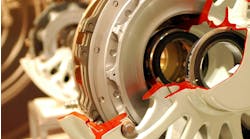Hydraulics Undergoing a Technological Revolution
The hydraulics industry is currently undergoing a technological revolution due to a greater integration of electronics within hydraulic components and systems. Broader industry trends of electrification and automation are helping drive this, as well as the desire for more efficient and precise systems.
Power & Motion spoke with Matteo Arduini, President of Hydraulics, EMEA (Europe, Middle East and Africa) and Rick Martich, President of Hydraulics, Americas and SVP, Global Operations and Systems Sales at Helios Technologies about these and other market trends impacting the hydraulics industry.
*Editor's Note: Questions and responses have been edited for clarity.
Power & Motion (P&M): What trends or market factors do you feel had the largest impacts on hydraulic component and system designs in 2023? Please explain what those trends are and how specifically they impacted the design of hydraulics.
Arduini and Martich: In 2023, the hydraulic components and system design industry has seen significant shifts due to various trends and market factors.
One of the most significant developments is the rise of electrohydraulics. This new generation of components is increasingly being adopted as the market evolves, reflecting a larger trend towards more advanced, integrated solutions.
This shift is also evident in the increasing demand for "smart" electrohydraulic solutions. The market is moving away from defining and specifying hydraulics and electronics solutions in isolation. Instead, there is a push for these elements to be integrated into intelligent systems that offer enhanced efficiency and functionality.
Another crucial factor is the ongoing consolidation of manufacturers. Major mergers such as Danfoss/Eaton and Hydraforce/Rexroth have reshaped the landscape. This consolidation trend, coupled with the localization of hydraulic components by OEMs, is a response to the risks exposed by the COVID pandemic. It underscores the importance of having a streamlined supply base and in-region manufacturing, assembly, and supply capabilities.
The role of system integrators has also become more critical than ever. Collaborating with engineering houses to get products specified and implemented is now a key part of the process. Furthermore, the use of telematics and sensors has grown in importance, adding another layer of complexity and potential to the overall system.
The shift towards electrohydraulics (EH) is being driven by major OEMs' focus on technologies that deliver energy savings and economies of scale. These benefits align with the broader industry transition to electric vehicles (EVs). As a result, the design of hydraulic systems is being revolutionized to accommodate and optimize the use of EH components. This change has spurred innovation, leading to the development of more efficient and sustainable hydraulic solutions.
The need for products that can be sourced within regional markets has also influenced design considerations. It's becoming increasingly important to offer an improved value proposition, especially as competitors begin to replicate high-performing products, such as counterbalance valves. The design process now needs to consider not only performance, but also the ability to manufacture and supply these products locally. This trend is leading to designs that balance high performance with local availability, adding another layer of complexity to the design process.
P&M: How have you seen hydraulic component and system designs evolve in recent years?
Arduini and Martich: In recent years, the evolution of hydraulic components and system design has been driven by several key trends. The COVID-19 pandemic highlighted the need for a shift from customization to platform-based solutions. This change allows for standardized components that can be used across multiple systems, simplifying production, reducing costs, and increasing speed of delivery.
At the same time, advancements in technology and a focus on energy efficiency have led to an increased use of EH in components. This move aligns with global efforts to reduce energy consumption and carbon emissions. It also caters to the needs of the next generation of operators, who are more tech-savvy and comfortable with integrated electronic functionality.
To meet the demands of large global OEMs that assemble equipment worldwide, designs now need to be flexible enough to be used across multiple platforms. Moreover, as systems become more advanced, they're moving towards higher pressures and smaller, compact designs. These designs offer better performance and are easier to integrate into various applications. They also align with the industry's push for greater power density and efficiency.
Power & Motion: What are some of the key features or performance attributes your company is working to include with its hydraulic components and systems, or for which customers are asking?
Arduini and Martich: In response to emerging trends and customer demands, our company is actively working on enhancing key features and performance attributes within our hydraulic components and systems. We are driving a convergence between hydraulics and electronics product development to align more closely with evolving solution expectations.
Performance efficiency and EH technologies are also in our focus, given the rapid expansion of electricity use, outpacing all other technologies and forms of energy. This necessitates the delivery of smart, safe, and sustainable transport systems and solutions.
We are integrating automatic connections into our offerings, along with regional design and supply capabilities. Our designs are becoming increasingly user experience-driven, with integrated solutions that prioritize intuitive functionality. Energy-saving designs capable of meeting enhanced system performance are also being developed, prepared to handle increased pressures and flow rates.
Moreover, our development efforts are now leaning towards higher pressure systems and smaller block designs. This change aligns with the industry's move toward greater power density and compactness. Overall, we aim to create hydraulic components and systems that are efficient, user-friendly, versatile, and at the forefront of technology.
P&M: How much, if at all, are you seeing electronic alternatives taking the place of hydraulic components or systems? Can you offer some examples, and how you possibly see this trend progressing?
Arduini and Martich: We are observing a notable shift from traditional hydraulics towards electronic alternatives in the industry. However, rather than resisting this change, we are enthusiastically embracing it. By integrating electronics into our hydraulic systems, we're innovating and creating smarter, more efficient products. A prime example of this is our ENERGEN™ valve, a groundbreaking device that ingeniously transforms hydraulic flow into electric power.
When it comes to smaller systems, we've observed that pneumatics and electric drives have managed to carve out a significant market share. However, replacing hydraulic components with electronic alternatives in larger systems presents a more formidable challenge. This trend is particularly evident in the realm of plant automation, where both electrical systems and pneumatics are becoming increasingly prevalent. As we continue to innovate and evolve, we anticipate this trend to progress further, potentially leading to greater adoption of electronic alternatives in lieu of traditional hydraulic systems.
P&M: Are you seeing a greater integration of electronics with hydraulics? If so, what are some examples you can share and the benefits of doing so?
Arduini and Martich: Absolutely, we are witnessing a greater integration of electronics with hydraulics. One notable example is electronic/hydraulic control modules which have brought about numerous benefits. These include improved integrated solutions, the strengthening and streamlining of supplier partnerships, and enhanced collaboration between solution creators, equipment manufacturers, and users.
Another example is the integration of controls and electronic actuators that have significantly enhanced the performance and output of machines. As electronics become more prevalent in the industry, we're seeing substantial improvements in overall capability and precision.
The surge of electronics in the hydraulic field over the last two decades has been impressive. It provides an efficient solution, particularly when the system cannot accommodate sophisticated servo systems. The marriage of electronics and hydraulics allows for a more cost-effective approach to achieving high levels of performance and precision.
P&M: Do you foresee any new trends or market factors impacting hydraulic designs in the coming year or years? If so, what are those and what impact will they have?
Arduini and Martich: Yes, we anticipate some notable trends and market factors which are likely to affect hydraulic designs in the forthcoming years. One significant trend is the continued proliferation of electronics in the industry. This trend is expected to enhance solution efficiency, increase the viability of solutions, and better align our offerings with market expectations.
Additionally, while there has been a steady push towards reducing reliance on hydraulics over the years, it's important to recognize that this technology will always have a unique role, particularly when brute force is needed. The principles of Pascal's law, which forms the basis of hydraulics, remains unaltered and continues to be a crucial aspect of design. Thus, even as we adapt to new trends, the fundamental role of hydraulics, especially in high power applications, will remain significant.





